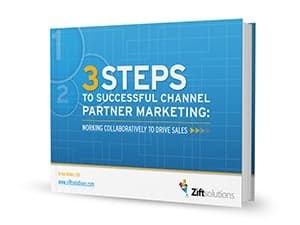Dramatic shifts in today’s sales environment are driving big changes in channel marketing. Our latest eBook provides essential insight into the current state of channel partner marketing and also shows you exactly how to tackle supplier and partner challenges. Before you can address those challenges, it’s important to understand the changes affecting the channel sales and marketing landscape.
It’s a Buyer’s Market
It’s a buyer’s market – and prospects have changed the way they evaluate and purchase big ticket items. Instead of contacting a salesperson directly, today’s buyers typically kick off the research process with an Internet search. When they do reach out to an actual sales professional, they’ve already scoured the Web for relevant data regarding the goods and services they desire. Thus, the burden of delivering pre-sales product information, including key differentiators and value propositions, has largely shifted from sales to marketing. Responding to and supporting this shift amplifies the importance of marketing and calls for critical changes in how companies structure and deliver content to prospects.
Self-Directed Learning Requires New Tactics
Traditional marketing tactics just don’t cut it anymore. Today, targeted content marketing is required to effectively capture the attention of buyers engaged in self-directed learning. Marketers must generate and push quality, customized content to buyers that is relevant to where they are in the buying cycle. And marketers often need new resources, including marketing automation tools, such as those provided by Zift Solutions, Eloqua, Marketo, ExactTarget and Hubspot, to deploy content marketing effectively and manage leads throughout the sales lifecycle.
Taking On Channel Partner Marketing Challenges
Unfortunately, most channel partners lack the marketing experience and resources to take on the challenges brought on by the sales environment evolution. To significantly impact channel partners’ pipelines and results, suppliers have an opportunity (if not responsibility) to step up and help their partners:
- Provide access to infrastructure, solutions and strategic insight to effectively leverage content marketing
- Build effective marketing campaigns, including developing a multi-tactic strategy, setting the stage for collaboration and nurturing demand.
- Deliver continued success through optimization, which involves active monitoring, analysis and tweaks to provide value and capture sales.

Be sure to check out “3 Steps to Successful Channel Partner Marketing: Working Collaboratively to Drive Sales” and learn how to:
- Build an Effective Marketing Campaign
- Secure Channel Partner’s Buy-in
- Deliver Continued Success through Optimization.
Ken Romley
Ken is a driving force behind Zift’s strategic vision and mission to offer channel marketing automation solutions to help global brands drive channel revenue. Ken has co-founded and run a wide range of technology and Internet-based enterprises while leading innovations in marketing technologies.




